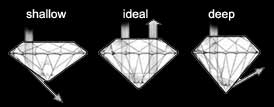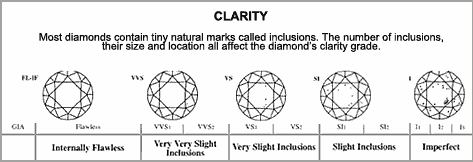How to Buy a Diamond
When buying a diamond, it is vitally important to know
about the 4 C's. They are cut, color, clarity, and carat
weight. Together, the 4 C's determine a diamond's value.
It is essential to learn about each of the 4 C's before
purchasing a diamond because each C speaks differently to
each individual. For some, the carat weight is the most
important while for others it is the cut.
Cut
To many, cut is the most important of the 4 C's. Each diamond
is cut using an exact mathematical formula that unleashes
its brilliance and fire. It also refers to the number of
facets that the diamond has. The most common cut is the
round brilliant. The round brilliant has 58 flat, polished
facets that reflect the maximum amount of light. The mathematical
formula also takes into account the depth of the cut. If
a diamond is cut too shallow or too deep it will lose some
of its fire. A well-cut diamond will reflect the light and
refract it back out to your eye. Cut is not to be confused
with shape.

Color
While diamonds come in every color of the spectrum, the
most valuable diamond color is colorless. Truly colorless
diamonds are extremely rare and as a result are expensive.
They are graded on a color scale established by the Gemological
Institute of America (GIA). Diamonds range from D (colorless)
to Z. The further down in the alphabet the diamond is, the
more yellow it appears. Color can best be determined by
looking at a loose diamond on a pure white surface, and
by noting any contrast.

Carat
Some people believe that carat refers to the size of a diamond
while in actuality; carat is the term used to measure a
diamond's weight. A carat is equal to 200 milligrams, and
there are 142 carats to an ounce. One carat is made up of
one hundred points. The larger the diamond, the greater
its rarity. Because larger diamonds are more rare, they
generally have a greater value per carat.

Clarity
Internal imperfections and external irregularities affect
the clarity of the diamond by interfering with the passage
of light throughout the stone. Imperfections such as spots,
lines, or bubbles are known as inclusions. The diamond is
more valuable when it has fewer inclusions. According to
the GIA's quality analysis system, clarity is graded on
a scale ranging from flawless (FL or IF) to imperfect (I).
The system is based on the visibility of inclusions at a
magnification of 10x.

While these are the 4 most recognized C's, a fifth and
less recognized, yet equally important C does exist. That
is Confidence. Confidence in your jeweler is extremely important
when buying this piece of jewelry that will last forever,
and be passed down among generations. It is important to
shop at a professional jeweler, one that is a member of
a professional trade association such as Jewelers of America
(JA). JA requires high ethical standards of its members
and provides them with ongoing education.

